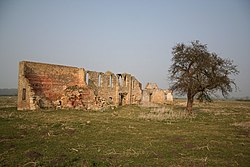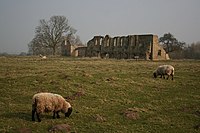Tupholme Abbey
Tupholme Abbey was a Premonstratensian abbey in Lincolnshire, sited close to the River Witham some ten and a half miles east of the county town, the City of Lincoln. Today the ruins are to be found off the B1190 between Bardney and Horncastle.[1]
The Witham valley in Lincolnshire is notable for its high concentration of monasteries: there were six on the east bank and three on the west, all presumably drawn to the area by the usefulness of the River Witham for transport and by the wealth (in wool) that it transported.[2] The abbey was largely destroyed by 1538, after being seized during Henry VIII's Dissolution of the Monasteries.
The abbey ruin is a Grade I listed structure.[3] It is maintained by Heritage Lincolnshire, and may be visited, free of charge, any day, from dawn until dusk.[4]
Contents
The Premonstratensian Order
The Order of Canons Regular of Prémontré, known as the 'Premonstratensians' or 'Norbertines', were a prominent monastic order founded in the twelfth century in France by Norbert of Xanten, who later became Archbishop of Magdeburg. In Great Britain and Ireland they were known asas the White Canons from the colour of their habit. The order's first house in England was Newsham Abbey (or Newhouse) Abbey, in Lincoln. There came to be nine Premonstratensian houses in Lincolnshire, Tupholm among them.
Tupholme Abbey was founded between 1155 and 1165 by Gilbert and Alan de Neville, upon which twelve canons were sent from Newsham Abbey.[4][5][6]
The original endowment of Tupholme Abbey embraced the demesne at Tupholme and other smaller parcels of land, along with the churches of Burreth, Middle Rasen, Market Stainton, Ranby, and Sturton. Later, in 1329, Henry, Earl of Lancaster (c. 1281-1345) granted the Lincolnshire manor of Burreth, and in 1342 Ralf de Neville donated that of Ranby.
However, Tupholme was never a prosperous house. In 1347, when the abbey was heavily in debt, an enterprising abbot was accused of "forgery and counterfeiting of coin of the realm", allegedly using the proceeds to buy corn and wine, which he sold for a profit. Records of visitations in the later years of the abbey also show some misdemeanours: in 1497 Thomas Pynderwelle was banished to Croxton Abbey in Leicestershire as he was said to have become involved with a local woman called Philippa and fathered her child. In 1482 the behaviour of the canons had evidently been unruly, as they were forbidden to leave the precincts of the abbey without permission, or to sit up drinking after Compline (the last service of the day). The penalty for such misdeeds was to be three days on a bread and water diet.[4]
Tupholme was suppressed in 1536, in the first wave of the Dissolution of the Monasteries. The last abbot, John Ancaster, was given a pension of £18 and eight other canons received £1 each.[6]
After dissolution
The site of the abbey, together with the church, bell tower and churchyard, was granted to Sir Thomas Heneage of Hainton, of a family prominent in the court of King Henry VIII.
It seems likely that the church was demolished at an early stage for building material. Heneage built a grand house, based on the monastic buildings, for his daughter Elizabeth and her husband William Willoughby, 1st Baron Willoughby of Parham. The new house was in the fashionable Tudor style and surrounded by a large Tudor formal garden, of which traces remain on the site.
The mansion passed through the Willoughby family until it was sold in 1661 by the then Lord Willoughby, onetime Governor of Barbados (after whom was named the brief and disastrous colony of Willoughbyland on the coast of South America).
The was bought by Sir Thomas Vyner, a gold dealer and former Lord Mayor of London was that same year created a baronet by King Charles II.
By 1700 the Tudor style of the house was deemed unfashionable and the Vyners demolished it, to replace it with a house in the classical style, called Tupholme Halll, built 800 yards north-east of the abbey site. They retained just the one surviving wall of the mediæval abbey as an ornament in the landscaped parkland.[4] However in the 1730s the Vyners moved to Gautby Hall, and let Tupholme to tenants. In the 18th century, a farmyard developed around the site of the remaining wall. By the start of the 20th century this had become a busy farmstead, but by the middle of that century it had declined and the site was used only for labourers' housing, by the 1970s becoming empty and derelict and despite attempts to save it, was demolished in 1984.
In 1988 the site was acquired by Heritage Lincolnshire, and the ruin was repaired and opened to the public.
The ruins today
The surviving monastic ruin at Tupholme now comprises a single wall, standing two storeys high, virtually to eaves height. It has small square-headed windows lighting the lower storey which was a vaulted undercroft. The upper floor was the refectory of the abbey and has beautiful lancet windows and a very fine reader's pulpit. The reader's pulpit has clearly been 'prettified', presumably as part of the Vyners' landscaping scheme.[4]
Outside links
| ("Wikimedia Commons" has material about Tupholme Abbey) |
- B.B. Daubney, Pictures of Tupholme Abbey
- F. Frith, Historic maps of Tupholme Hall Farm
- Pictures on ipernity.com:
References
- ↑ "Tupholme Abbey". https://www.heritagelincolnshire.org/sites/tupholme-abbey. Retrieved 29 July 2018.
- ↑ "Account of Witham Valley". Archived from the original on 30 June 2013. https://web.archive.org/web/20130630105718/http://www.lincsheritage.org/community_heritage/guides_information/witham_abbeys/index.php. Retrieved 20 February 2011.
- ↑ National Heritage List 1017403: Tupholme Abbey (Grade I listing)
- ↑ 4.0 4.1 4.2 4.3 4.4 "Heritage Trust page for Tupholme Abbey". http://www.lincsheritage.org/community_heritage/guides_information/witham_abbeys/site.php?key=tupholme_abbey. Retrieved 3 September 2007.
- ↑ National Monuments Record: No. 351367 – Tupholme Priory
- ↑ 6.0 6.1 A History of the County of Lincoln - Volume 2 pp 206–207: Houses of Premonstratensian canons: The abbey of Tupholme (Victoria County History)


